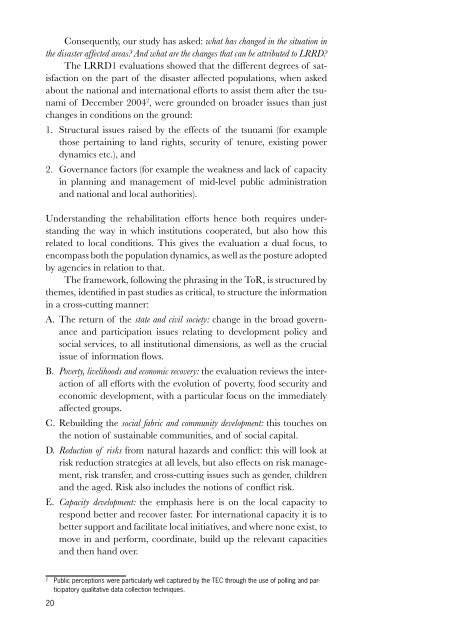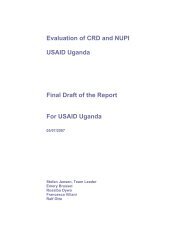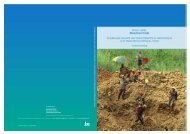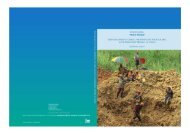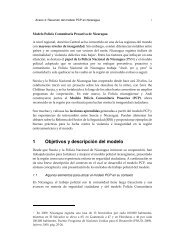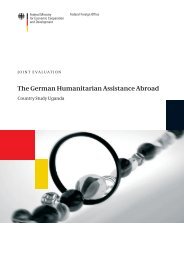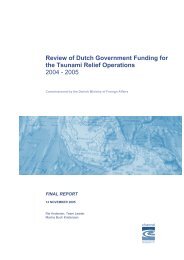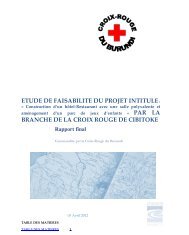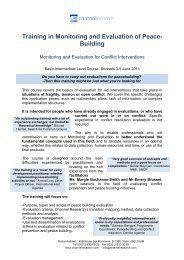A ripple in development? - Channel Research
A ripple in development? - Channel Research
A ripple in development? - Channel Research
You also want an ePaper? Increase the reach of your titles
YUMPU automatically turns print PDFs into web optimized ePapers that Google loves.
Consequently, our study has asked: what has changed <strong>in</strong> the situation <strong>in</strong><br />
the disaster affected areas? And what are the changes that can be attributed to LRRD?<br />
The LRRD1 evaluations showed that the different degrees of satisfaction<br />
on the part of the disaster affected populations, when asked<br />
about the national and <strong>in</strong>ternational efforts to assist them after the tsunami<br />
of December 2004 2 , were grounded on broader issues than just<br />
changes <strong>in</strong> conditions on the ground:<br />
1. Structural issues raised by the effects of the tsunami (for example<br />
those perta<strong>in</strong><strong>in</strong>g to land rights, security of tenure, exist<strong>in</strong>g power<br />
dynamics etc.), and<br />
2. Governance factors (for example the weakness and lack of capacity<br />
<strong>in</strong> plann<strong>in</strong>g and management of mid-level public adm<strong>in</strong>istration<br />
and national and local authorities).<br />
Understand<strong>in</strong>g the rehabilitation efforts hence both requires understand<strong>in</strong>g<br />
the way <strong>in</strong> which <strong>in</strong>stitutions cooperated, but also how this<br />
related to local conditions. This gives the evaluation a dual focus, to<br />
encompass both the population dynamics, as well as the posture adopted<br />
by agencies <strong>in</strong> relation to that.<br />
The framework, follow<strong>in</strong>g the phras<strong>in</strong>g <strong>in</strong> the ToR, is structured by<br />
themes, identified <strong>in</strong> past studies as critical, to structure the <strong>in</strong>formation<br />
<strong>in</strong> a cross-cutt<strong>in</strong>g manner:<br />
A. The return of the state and civil society: change <strong>in</strong> the broad governance<br />
and participation issues relat<strong>in</strong>g to <strong>development</strong> policy and<br />
social services, to all <strong>in</strong>stitutional dimensions, as well as the crucial<br />
issue of <strong>in</strong>formation flows.<br />
B. Poverty, livelihoods and economic recovery: the evaluation reviews the <strong>in</strong>teraction<br />
of all efforts with the evolution of poverty, food security and<br />
economic <strong>development</strong>, with a particular focus on the immediately<br />
affected groups.<br />
C. Rebuild<strong>in</strong>g the social fabric and community <strong>development</strong>: this touches on<br />
the notion of susta<strong>in</strong>able communities, and of social capital.<br />
D. Reduction of risks from natural hazards and conflict: this will look at<br />
risk reduction strategies at all levels, but also effects on risk management,<br />
risk transfer, and cross-cutt<strong>in</strong>g issues such as gender, children<br />
and the aged. Risk also <strong>in</strong>cludes the notions of conflict risk.<br />
E. Capacity <strong>development</strong>: the emphasis here is on the local capacity to<br />
respond better and recover faster. For <strong>in</strong>ternational capacity it is to<br />
better support and facilitate local <strong>in</strong>itiatives, and where none exist, to<br />
move <strong>in</strong> and perform, coord<strong>in</strong>ate, build up the relevant capacities<br />
and then hand over.<br />
2<br />
Public perceptions were particularly well captured by the TEC through the use of poll<strong>in</strong>g and participatory<br />
qualitative data collection techniques.<br />
20


